11 Aug 2025
14 MIN READ
What is the Non-Aligned Movement?
Summary
The Non-Aligned Movement (NAM) is a group of countries that choose officially not to align with the Cold War superpowers. Originating from the 1955 Bandung Conference, NAM promoted sovereignty, peaceful coexistence, and anticolonialism. It became a major voice for newly independent nations, especially in the UN.
Post-Cold War, NAM shifted focus to economic development, climate justice, and South-South cooperation. Though criticized for political ineffectiveness and internal divisions, it remains a key platform for the Global South's interests today.
Brief History of Cold War Non-Aligned Movement and the Need for Neutrality
During the Cold War, in 1961, the world was divided into two main geopolitical blocs: the capitalist West, led by the United States, and the communist East, led by the Soviet Union. Many nations were under considerable pressure to choose a side and were even forced to take one by various coup interventions.
Many went on to adopt the ideologies, politics, and military strategies of these superpowers. But some countries didn’t want to be part of this binary rivalry. Amid this significant geopolitical divide, another option emerged called the Non-Aligned Movement. This movement united newly independent countries in Asia, Africa, and Latin America, which were recently decolonized in the 1950s and 1960s.
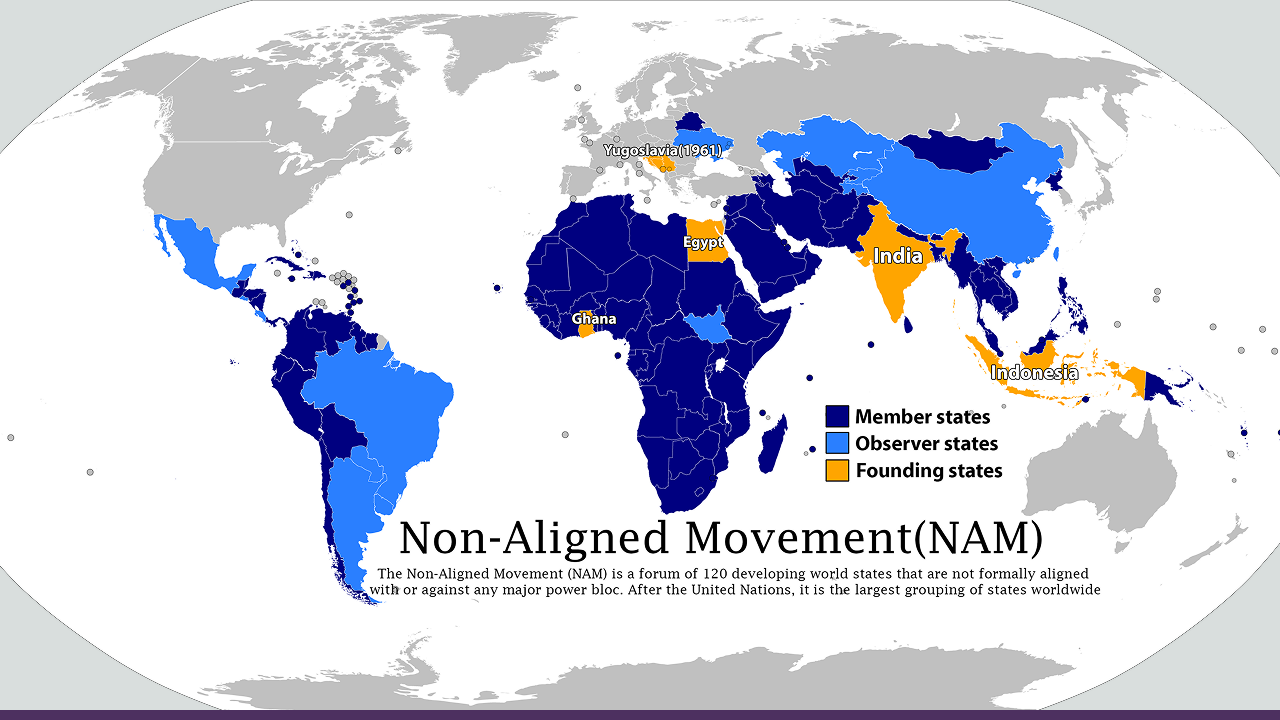
Representation of member, observer, and founding states of the Non-Aligned Movement (NAM), highlighting global participation from Asia, Africa, Latin America, and the Middle East. Credits: The Transnational
Leaders like Josip Broz Tito of Yugoslavia, Jawaharlal Nehru of India, Kwame Nkrumah of Ghana, Sukarno of Indonesia, and Gamal Abdel Nasser of Egypt guided the movement to become a suitable alternative to a single sphere of influence, creating a more balanced global order.
NAM’s goal was to promote global peace and cooperation without being drawn into the Cold War’s ideological battles. It’s still an organization today with 120 members, making it the second-largest multinational organization after the United Nations. Uganda currently has the presidency.
Structure, Membership Criteria, and Functioning of the Non-Aligned Movement
As a condition for membership, the states of the Non-Aligned Movement cannot be part of a multilateral military alliance (such as the NATO) or have signed a bilateral military agreement with one of the “big powers” if it was “deliberately concluded in the context of great power conflicts.
However, the concept of nonalignment does not imply that a state should remain passive or neutral in international politics. On the contrary, from its founding, the Non-Aligned Movement has had as its stated aim to give a voice to developing countries and to encourage their concerted action in world affairs.
Unlike the United Nations (UN) or the Organization of American States, the Non-Aligned Movement has no formal constitution or permanent secretariat. All members of the Non-Aligned Movement have equal weight within its organization. The movement’s positions are reached by consensus in the Summit Conference of Heads of State or Government, which usually convenes every three years.
The administration of the organization is the responsibility of the country holding the chair, a position that rotates at every summit. The ministers of foreign affairs of the member states meet more regularly to discuss common challenges, notably at the opening of each regular session of the UN General Assembly.
Founding of the Non-Aligned Movement
The Bandung Conference (1955)
The Non-Aligned Movement began at the Bandung Conference in Indonesia in 1955. This event united 29 Asian and African nations that were emerging from colonial rule. Leaders such as Nehru (India), Sukarno (Indonesia), and Nasser (Egypt) formed a collective commitment to mutual respect, non-aggression, and non-interference.
The conference aimed to help countries stay independent from Cold War power blocs. It also promoted peace, cooperation, and anti-colonial solidarity.
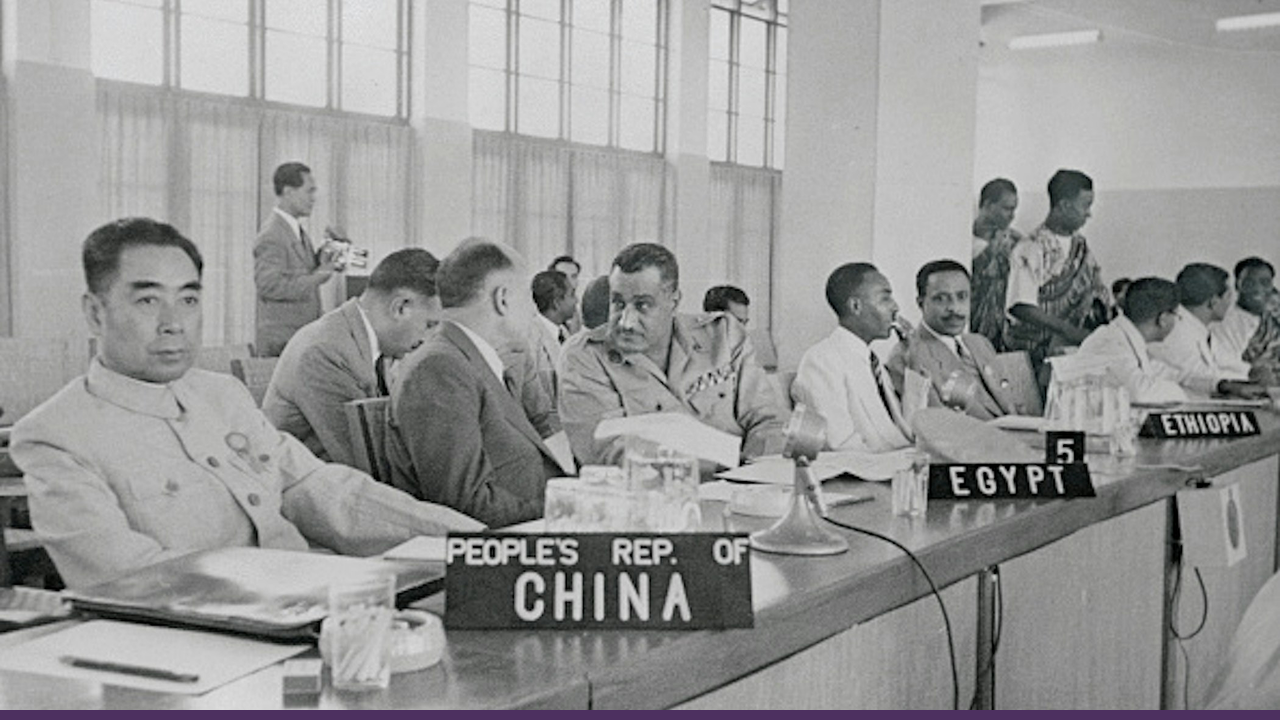
Leaders from the People's Republic of China, Egypt, and Ethiopia attending the 1955 Bandung Conference, a key event in the foundation of the Non-Aligned Movement. Credits: Getty
Founding members of NAM
Five key nations played vital roles in founding NAM:
-
India
-
Yugoslavia
-
Egypt
-
Indonesia
-
Ghana
The Belgrade Summit (1961)
The first official summit of the Non-Aligned Movement happened in Belgrade, Yugoslavia, in 1961. Tito organized the summit and 25 countries attended it: Afghanistan, Algeria, Burma (Myanmar), Cambodia, Ceylon (Sri Lanka), Congo-Leopoldville (DRC), Cuba, Cyprus, Egypt, Ethiopia, Ghana, Guinea, India, Indonesia, Iraq, Lebanon, Mali, Morocco, Nepal, Saudi Arabia, Somalia, Sudan, Tunisia, Yemen and Yugoslavia.
These nations were seeking a third path between the Western and Eastern blocs. The leaders showed their commitment to neutrality and peaceful coexistence as they were also opposed to neocolonialism.
Principles and Objectives of the Non-Aligned Movement
Ten Bandung Principles of the NAM
The Ten Principles of Bandung, established at the Asian-African Conference in Bandung, Indonesia, in 1955, form the core of the Non-Aligned Movement. These principles are pivotal to its foundation.
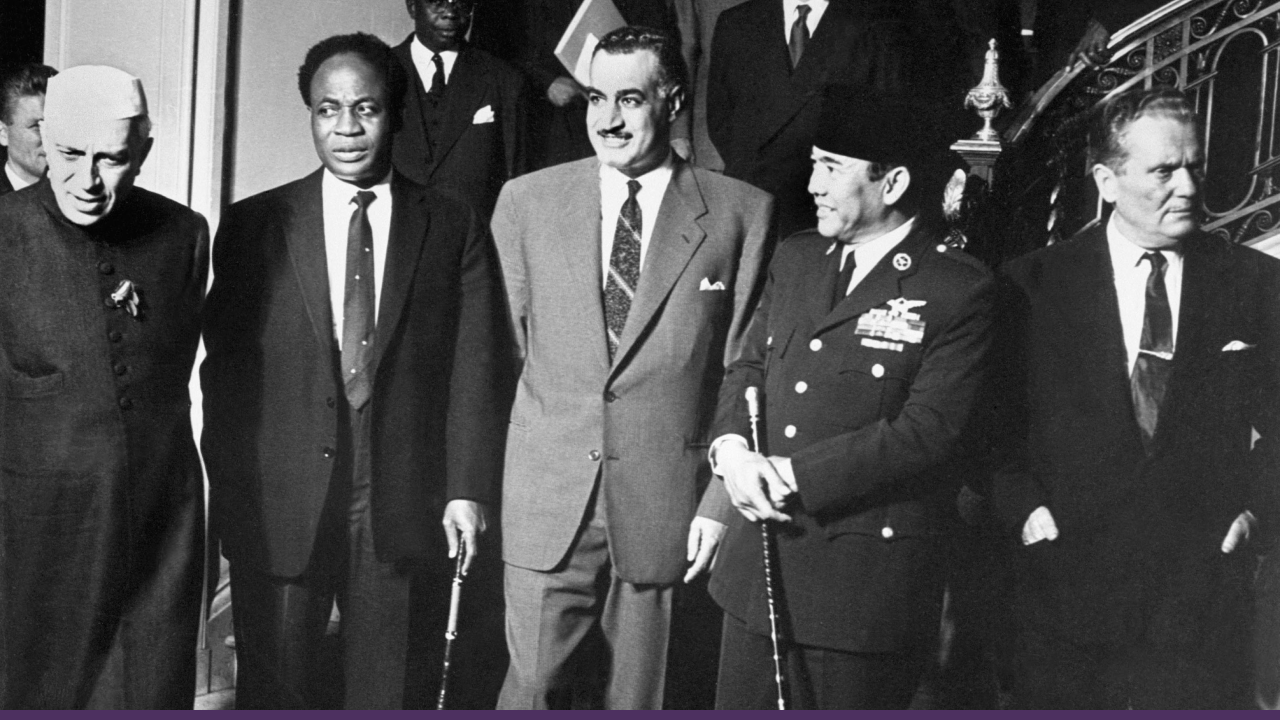
Founding leaders of the Non-Aligned Movement, Nehru, Nkrumah, Nasser, Sukarno, and Tito, during the 1961 Belgrade Summit. Credits: Reuters
-
Respect for fundamental human rights, and for the purposes and principles of the Charter of the United Nations
-
Respect for the sovereignty and territorial integrity of all nations
-
Recognition of the equality of all races and the equality of all nations, large and small
-
Abstention from intervention or interference in the internal affairs of another country
-
Respect for the right of each nation to defend itself, singly or collectively, in conformity with the Charter of the United Nations
-
Abstention from the use of arrangements of collective defense to serve the particular interests of any of the big powers, and abstention by any country from exerting pressures on other countries
-
Refraining from acts or threats of aggression or the use of force against the territorial integrity or political independence of any country
-
Settlement of all international disputes by peaceful means, such as negotiation, conciliation, arbitration, or judicial settlement, as well as other peaceful means of the parties’ own choice, in conformity with the Charter of the United Nations
-
Promotion of mutual interests and cooperation; and
-
Respect for justice and international obligations
Non-intervention and peaceful resolution of conflicts in NAM
A key part of NAM’s philosophy is the principle of non-intervention in the internal matters of sovereign states. This idea comes from the post-colonial wish for autonomy and security. NAM has always condemned foreign military actions, regime changes, and outside pressure.
The Movement advocates for peaceful conflict resolution through diplomacy, dialogue, and the application of international law. It also promotes the United Nations as a neutral mediator.
In current conflicts, from the Middle East to Africa, the NAM continues to advocate for negotiated solutions rather than resorting to force.
Promote development and South-South cooperation
NAM sees development as essential for genuine independence. It recognizes the common history of colonial exploitation. The movement supports South-South cooperation, which fosters partnerships among developing nations. This cooperation focuses on areas such as infrastructure, health, education, and technology transfer.
The aim is to lessen dependence on Western aid and confront global financial institutions. NAM utilizes trade agreements, regional integration, and knowledge sharing to build a fairer and more self-sufficient Global South.
Role of the Non-Aligned Movement During the Cold War
Influence at the UN and international forums
The Non-Aligned Movement played a key role in shaping discussions and outcomes at the United Nations and other international forums. Representing a significant portion of the world's population, NAM countries acted as a united voice for developing nations that chose not to align with either NATO or the Soviet Union. Many of these nations were embroiled in proxy wars, and NAM worked to bring their plight to the global stage.
NAM members frequently supported resolutions for decolonization, anti-apartheid efforts, and economic justice. They used their collective voting power in the UN General Assembly to influence global policy. Beyond votes, NAM leveraged its moral authority to speak out against global injustices and advocate for sovereignty, human rights, and non-intervention.
The movement also became a strong proponent of a New International Economic Order (NIEO) in the 1970s, advocating for fairer trade terms, greater control over natural resources, and the sharing of technology, aiming to reverse the economic imbalances rooted in colonial history.
Advocacy for disarmament, peace, and equality
NAM consistently advocated for a more peaceful and equitable world by calling for global nuclear disarmament and a halt to the arms race. They were designed to promote economic equality between developed and developing nations. The bloc as a whole firmly opposed racial discrimination, apartheid, and all forms of colonialism and imperialism.
NAM also encouraged cultural and educational cooperation, aiming to decolonize knowledge and challenge Western-dominated narratives in global institutions, such as UNESCO. While some of these values weren’t always practiced within member states, the collective vision remained centered on justice, sovereignty, and equitable development.
Internal contradictions and challenges
Despite its ideals, the NAM faced significant internal challenges. Member states had different political ideologies, strategic interests, and economic dependencies, making unity difficult. Some countries leaned toward a superpower for military aid or economic reasons, undermining the very principle of non-alignment.
Conflicts between member states, such as India and Pakistan or Iraq and Iran, challenged the bloc’s ability to present a unified stance. In such cases, NAM struggled to mediate effectively, exposing the limits of solidarity in the face of regional tensions.
Yet, despite these challenges, NAM remained active in mediating Cold War tensions, offering a platform for dialogue and encouraging peaceful solutions to global conflicts, including efforts to de-escalate tensions in regions such as Vietnam and the Middle East.
NAM’s role in post-Cold War diplomacy
After the Cold War, NAM sought a fairer international system. It backed multilateralism, emphasized state sovereignty, and encouraged peaceful conflict resolution. Although its influence on global decisions declined, NAM stayed active in UN debates and other platforms. It often acted as a united voice for the Global South.
Evolution of Non-Aligned Movement From Political Neutrality to Economic Development

Josip Broz Tito, leader of Yugoslavia and founding figure of the Non-Aligned Movement. Credits: Karsh
With the Soviet Union gone and the US and NATO aligned, the NAM shifted its focus from political neutrality to economic growth. Member states prioritized trade, poverty reduction, access to technology, and economic cooperation. They emphasized South-South partnerships. They aimed to make globalization benefit developing nations, reduce inequalities, and economic disparities.
Focus on globalization, climate change, inequality
As global issues evolved, NAM expanded its focus. The widening gap between rich and poor nations has become a significant concern, especially as globalization has deepened inequalities. Climate change also took center stage, despite contributing the least, low-income countries suffer the most. Yet, wealthier nations often shift the blame.
NAM advocates for climate justice, sustainable development, and more equitable global policies. It also advocates for health equality, access to education, and supports the rights of the Global South.
The Non-Aligned Movement’s Criticism and Challenges
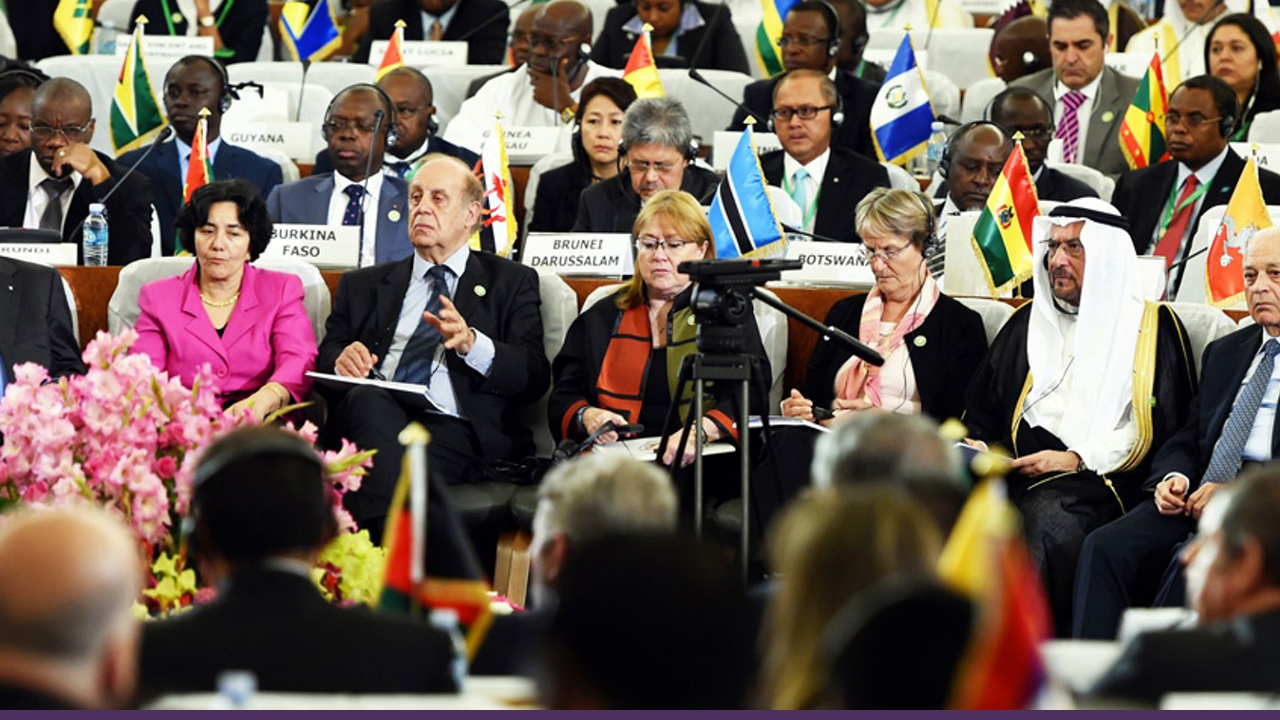
Foreign ministers from around the world gathered in Algiers for the 17th Ministerial Conference of the Movement of Non-Aligned Countries. Credits: Getty
Accusations of political ineffectiveness
Many critics argue that the Non-Aligned Movement has little political influence in today’s multipolar world. While NAM was a powerful force during the Cold War, its influence has since waned. Today, it continues to issue statements and declarations on global issues, but it lacks effective enforcement mechanisms and has limited influence over major international decisions.
Critics often argue that NAM is now more of a symbol than a force for change. For instance, despite its strong condemnation of Israeli actions in the Israeli-Palestinian conflict and its long-standing support for Palestinian statehood, NAM has been unable to influence the situation in any meaningful way.
Divisions among members
The Non-Aligned Movement also faces internal challenges due to the sheer diversity of its 120 member states. These countries differ widely in political systems, economic structures, regional interests, and foreign priorities. This diversity makes unity a challenging goal to achieve.
Member states often take opposing positions on key issues such as military alliances, trade relations, and human rights. Long-standing disputes, such as those between India and Pakistan or the historical tensions between Iraq and Kuwait, underscore the challenges in forming a unified stance.
Trying to unite over 100 countries into a single political voice has proven to be a persistent obstacle. These divisions severely limit NAM’s ability to take coordinated action, making it difficult for the organization to function as a cohesive bloc. While NAM leaders frequently emphasize solidarity, practical unity remains elusive.
Debate over modern relevance
As global politics change form, some question the relevance of the Non-Aligned Movement. In a world without two superpowers, many consider non-alignment to be an outdated and obsolete concept. Today’s geopolitical environment is shaped by multipolar competition, regional alliances, and emerging challenges such as climate change, cybersecurity, global inequality, and digital surveillance.
Critics argue that NAM has struggled to adapt to these changes and has failed to articulate a modern, compelling agenda. However, some supporters believe it still serves as a vital platform for developing countries to unite and avoid being left behind in global decision-making.
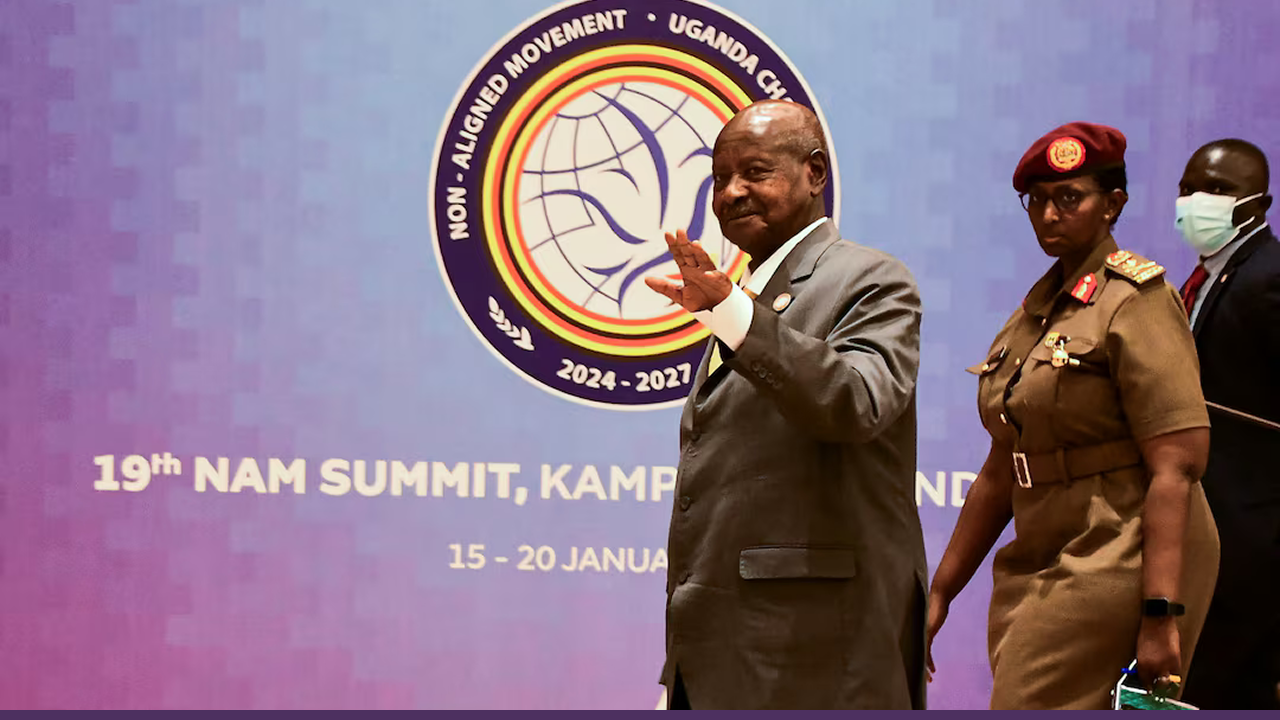
source-Ugandan President Yoweri Museveni at the 19th Non-Aligned Movement Summit in Kampala, January 2024. Credits: Reuters
Additionally, some countries have aligned more closely with emerging platforms, such as BRICS, which are primarily focused on economic cooperation and promoting the interests of the Global South. Some have already said it is the same movement in its new form, referring to it as even a partial successor to NAM. However, the two remain distinct: BRICS is more action-oriented and economically integrated, whereas NAM continues to function as a diplomatic and ideological forum.
Conclusion
The Non-Aligned Movement may not hold the same power it once did, but its mission is far from over. In a world still marked by inequality, conflict, and shifting alliances, NAM continues to offer a collective voice for developing countries, advocating for economic justice, climate action, and multilateral cooperation.
Despite internal divisions and criticism over relevance, its principles remain vital in a world still shaped by inequality and power imbalances. While newer blocs, such as BRICS, take the lead on economic issues, the NAM’s focus on political independence and unity among the Global South ensures it still has a role to play.
People Also Ask
What are the aims of NAM?
To promote peace, sovereignty, equality, non-intervention, and cooperation among developing nations, especially in global affairs.
What does NAM do?
NAM advocates for developing nations by promoting non-alignment, peaceful diplomacy, economic cooperation, and justice in international decision-making forums.
What are the five key principles of the Non-Aligned Movement?
The five principles are: mutual respect for each other's territorial integrity and sovereignty; mutual non-aggression; mutual non-interference in domestic affairs; equality and mutual benefit; and peaceful co-existence.
How many countries are members of the Non-Aligned Movement?
There are presently 120 members. It is the second-largest international organization after the United Nations.
Is the Non-Aligned Movement still active?
Yes, but not in the same capacity as it was during the Cold War.
